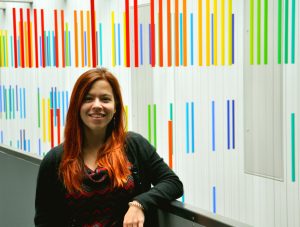 Having studied Chemistry at Edinburgh University, Maria enjoyed exploring different fields by undergoing a year in industry at Agfa-Gevaert, where she looked at differently coloured inkjet inks, before completing her Masters thesis under the supervision of Prof. J. Paul Attfield in the field of high-pressure syntheses of double perovskite materials. Then she moved on to Dresden where she’s currently investigating potentially new magnetic topological insulator candidates under Prof. Michael Ruck, while also being active in the local JungChemikerForum. She’s also active in the ct.qmat Cluster of Excellence, where she has been helping to explain quantum chemistry and physics as part of their YouTube series. Find her video here!
Having studied Chemistry at Edinburgh University, Maria enjoyed exploring different fields by undergoing a year in industry at Agfa-Gevaert, where she looked at differently coloured inkjet inks, before completing her Masters thesis under the supervision of Prof. J. Paul Attfield in the field of high-pressure syntheses of double perovskite materials. Then she moved on to Dresden where she’s currently investigating potentially new magnetic topological insulator candidates under Prof. Michael Ruck, while also being active in the local JungChemikerForum. She’s also active in the ct.qmat Cluster of Excellence, where she has been helping to explain quantum chemistry and physics as part of their YouTube series. Find her video here!
Today, we introduce her as she won a Presentation Award on the DGK Annual Meeting for her excellent Lightning Talk and her great poster presentation of her current research within the Ruck group on “Finite and Infinite Chains of Heavy-Atom Clusters”.
Tell us shortly what your poster is about.
My poster focuses on the discovery of new pseudo one-dimensional compounds. These compounds were investigated in the course of looking for new topological materials in compounds that consist predominantly of elements that exhibit strong spin orbit coupling. This has been shown to be a promising class of materials to investigate as the spin orbit coupling can cause an inversion in the band gap and hence lead to a topologically non-trivial material. Therefore, the poster focuses on the optimisation of the synthesis of Sn[PtBi6I12] crystals wherein infinite strands of the cluster compound are observed, while the compound with finite cluster strands, (Bi2xSn1–3x)[PtBi6I12], can be targeted via a separate synthesis [1]. This was achievable due to in-depth thermal analyses, which we could therefore showcase as a successful semi-empirical approach to make these new complex compounds. The crystals themselves had an edge-length of up to 1 mm and thus the physical properties could also be investigated.
Among all the heavy atoms, which element is your favorite?
That is a very difficult question to answer! I do have to say that bismuth has become one of my favourite heavy elements as it has such a great versatility in forming different types of structures and materials. And of course, the spin orbit coupling that it has is definitely beneficial to potentially finding new topological materials. I do have to add that rhenium does retain a soft spot in my heart though as I worked quite a lot with it during my Masters project.
How did you come to crystallography?
I fell into it! After my Bachelors year in industry, I wanted to try something completely different and hence switched over to inorganic and materials chemistry. During that project I got to use powder X-ray diffraction a lot and really enjoyed it. Hence when I found out that I would be able to expand on that with single-crystal X-ray diffraction in my PhD project, I jumped at the opportunity and haven’t looked back since.
References
- M. A. Herz, K. Finzel, M. Ruck: Design of High-Temperature Syntheses on the Example of the Heavy-Atom Cluster Compound Sn[PtBi6I12], Z. Anorg. Allg. Chem. (2022). 10.1002/zaac.202200080